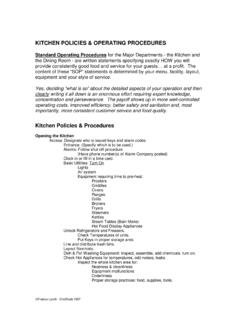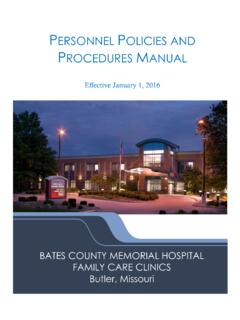Transcription of KITCHEN POLICIES & OPERATING PROCEDURES
1 KITCHEN POLICIES & OPERATING PROCEDURES . Standard OPERATING PROCEDURES for the Major Departments - the KITCHEN and the Dining Room - are written statements specifying exactly HOW you will provide consistently good food and service for your guests at a profit. The content of these SOP statements is determined by your menu, facility, layout, equipment and your style of service. Yes, deciding what is so about the detailed aspects of your operation and then clearly writing it all down is an enormous effort requiring expert knowledge, concentration and perseverance.
2 The payoff shows up in more well-controlled OPERATING costs, improved efficiency, better safety and sanitation and, most importantly, more consistent customer service and food quality. KITCHEN POLICIES & PROCEDURES Opening the KITCHEN Access: Designate who is issued keys and alarm codes Entrance: (Specify which is to be used.). Alarms: Follow shut-off procedure (Have phone number(s) of Alarm Company posted). Clock in or fill in a time card. Basic Utilities: Turn On Lights Air system Equipment requiring time to pre-heat: Proofers Griddles Ovens Ranges Grills Broilers Fryers Steamers Kettles Steam Tables (Bain Marie).
3 Hot Food Display Appliances Unlock Refrigerators and Freezers. Check Temperatures of units. Put Keys in proper storage area. Line and distribute trash bins. Layout floormats. Dish & Pot Washing Equipment: Inspect, assemble, add chemicals, turn on. Check Hot Appliances for temperatures, odd noises, leaks. Inspect the whole KITCHEN area for: Neatness & cleanliness Equipment malfunctions Orderliness Proper storage practices: food, supplies, tools. Francis Lynch - ChefDesk 1997. Check phone messages. Inspect Food Storage Areas for: Presence and condition of foods Proper storage practices: labels, dates, wrapping, location.
4 Distribute towels and other issued items to stations. Production Pre-Prep Check the reservations for special events/parties. Count current inventories of prepped menu items left from previous shift. Based on leftovers and/or a Daily Specials Plan, decide on any Specials . Refer to sales forecast for determining production requirements. Often a sales forecast is just knowing your daily sales pattern and factoring in very unusual weather or special events in your area that may increase or decrease traffic that day.
5 Experience plays a large role. Write a Prep List: Items, amounts and sequence. (Each cook should write their own prep list - guided by the chef). Preparation PROCEDURES Use established Par Stock Levels of Basic Menu Items and Foundations. (Often varies by the day of the week and shift.). Pull the items needed to begin cooking based on the prep lists. Pull items for the next shift or day, according to expected needs. Use written recipes for each Menu Item. Recipes should specify measurements, techniques, holding instructions portion sizes and plating instructions.
6 (Photographs of plated foods are recommended.). Firing Orders: Treat the servers with courtesy and respect. Know and Follow the written recipe PROCEDURES for cooking and plating. Follow one procedure for controlling the written orders: dupes or print-outs. Systems vary for holding orders: Wheels, snap-lines, check slides. Designate one person to manage the order-tickets and verbally firing orders. After the food is up, keep the tickets - do not discard. Turn in at end of service. Notify the service staff of imminent run-outs.
7 (Use a chalkboard system.). Ordering and Receiving Use Lists of Par (Raw Material) Stock Levels by category: Produce Dairy Meats, Poultry, Seafood Pastas, Rices, Grains Dry Goods, Condiments, Oils, Vinegars KITCHEN Alcohols - Liqueurs, Wines, etc. Herbs, Spices Bakery/Pastry items Beverages for Service Chemicals and Cleaning supplies Paper Goods KITCHEN Office supplies Refer to the Vendors List for Ordering: This list will quickly be unnecessary for experienced personnel because they will know which food is ordered from which vendor and when orders are made.
8 It is very helpful for new staff members. Francis Lynch - ChefDesk 1997. (The Vendor List should contain: Vendor Name Contact Persons (Sales rep and delivery person). Phone, Fax, email numbers of the sales rep General Item Categories supplied Day of week to order Day and approximate time of delivery.). Ordering Procedure Ordering & Receiving Form (Often the same piece of paper). This should show: Date item is put on list Item being Ordered (Be specific). Vendor to Order From Person Ordering Date Actually Ordered Check-box of receipt (upon Delivery).
9 Person Receiving Special Comments (Ordered from other vendor, substitute item delivered, out of stock, etc.). Receiving Procedure Use the Order Form to verify that items ordered came in Use Specified Rotation Rules (Typically FIFO : First In - First Out). Policy should state exactly where new items are to be stored on shelves in relation to identical items already on hand. (New items go to the left and/or in the back of and/or under old items, for instance.). Date dry goods (Indelible marker on item, usually).
10 Requisition or Usage PROCEDURES The size and complexity of the KITCHEN determine how formal this procedure may be. Formal systems use a requisition form filled out by production personnel , reviewed by a chef, given to a special person (steward) who issues the items, records the event, adjust the inventory level and may order more goods. Most kitchens just have the cooks go get their items themselves and do nothing more. Others allow the cooks to get their own foods but require a notation on a form listing what was taken, when and by whom.





